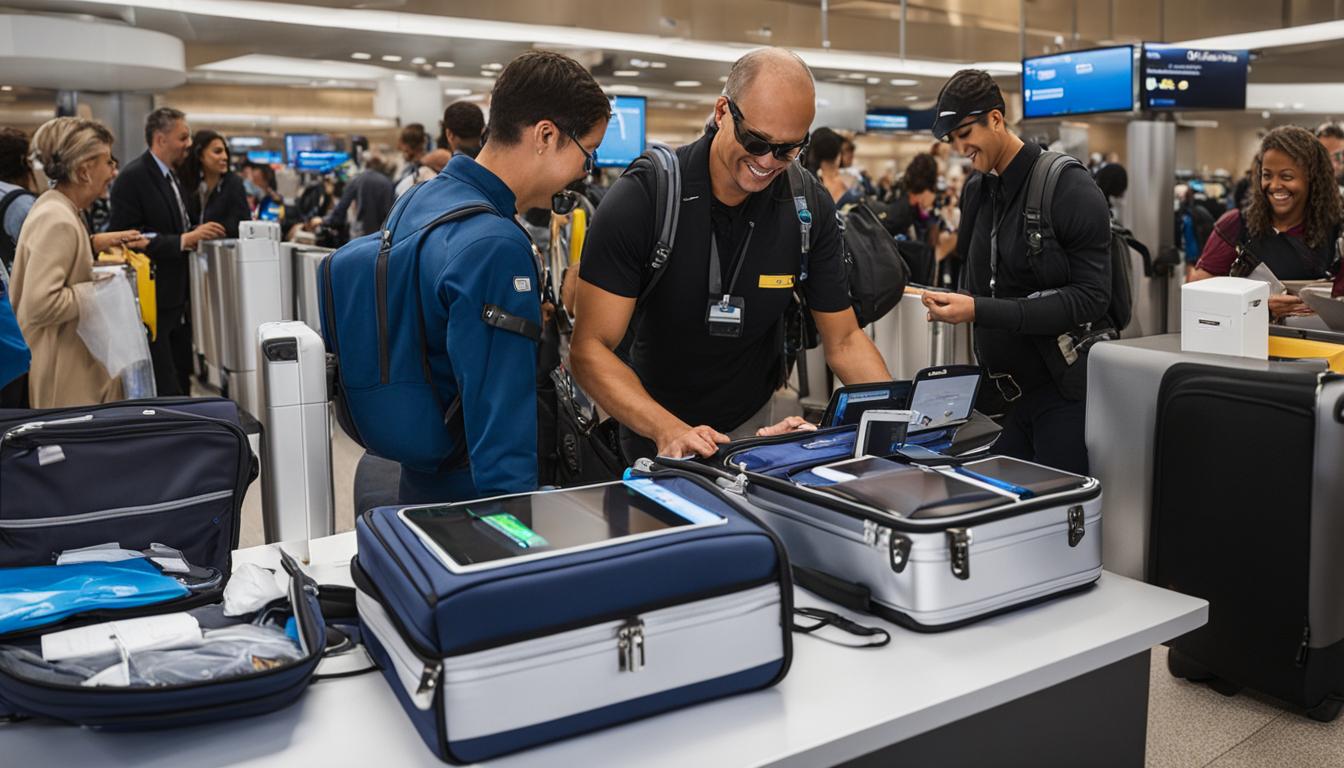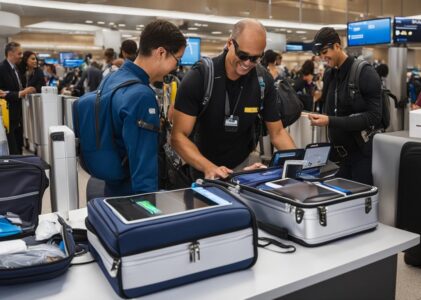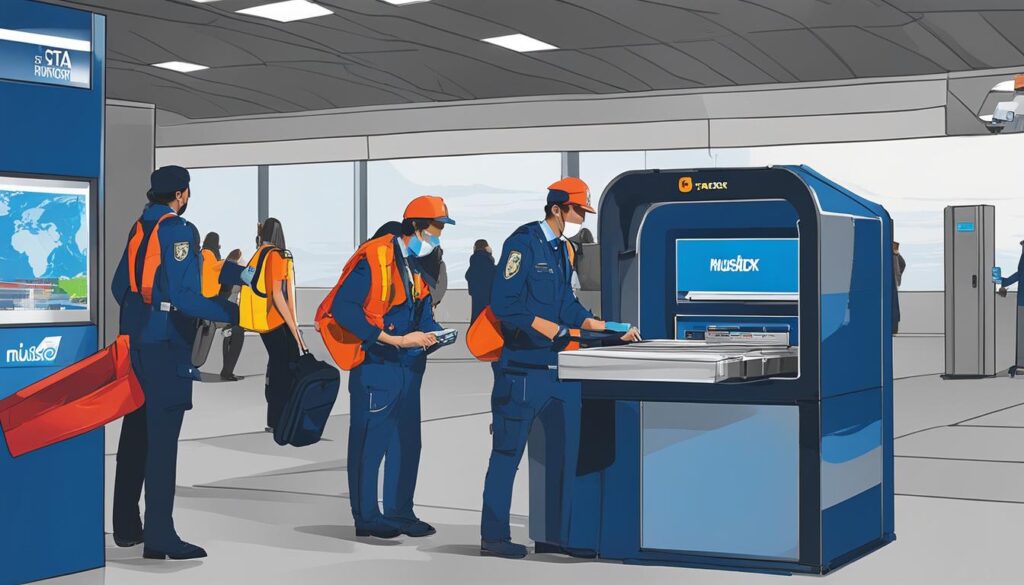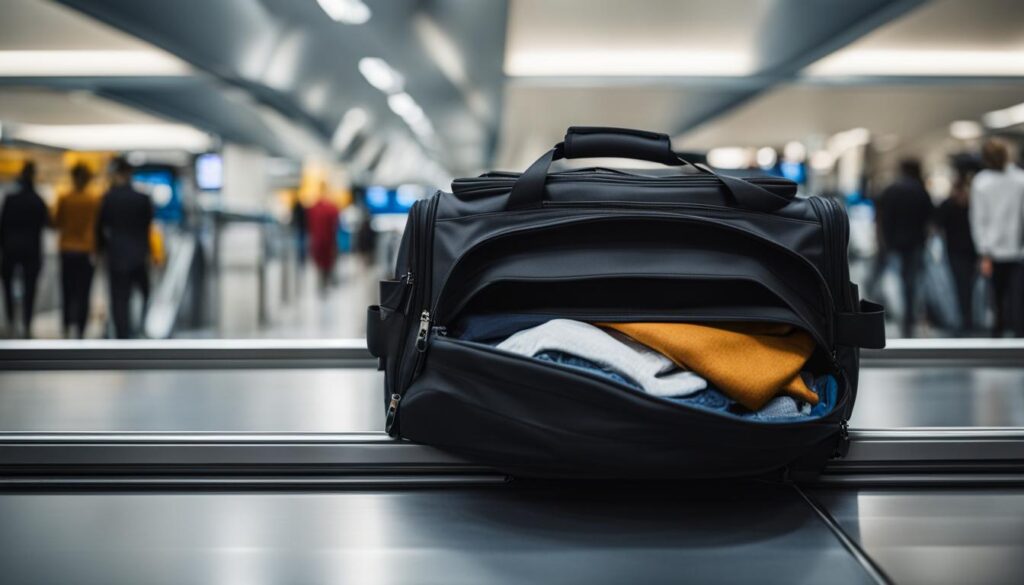As a frequent traveler, one question that often comes to mind is whether chargers are allowed in check-in baggage. It’s important to know the regulations to ensure a hassle-free journey. In this guide, I will provide you with all the information you need to know about bringing chargers with you when you fly.
Key Takeaways:
- Chargers, such as laptop chargers and phone chargers, are generally allowed in check-in baggage.
- If the charger has a built-in battery, it should be kept in your carry-on bag.
- Each airline may have its own specific rules, so it’s important to check their website or contact them directly for clarification.
- Chargers with lithium-ion batteries are not allowed in check-in baggage due to the fire risk they pose.
- Keeping chargers in your hand luggage has several advantages, including easy accessibility during your journey.
Potential Risks of Keeping Chargers in Check-In Baggage
When it comes to traveling with electronic chargers, it’s important to be aware of the potential risks associated with keeping them in check-in baggage. To ensure the safety of all passengers, airlines have implemented regulations regarding the transportation of chargers, especially those with lithium-ion batteries.
Lithium-ion batteries, commonly found in many electronic devices and chargers, pose a fire risk. These batteries have the potential to malfunction, suffer breaches, and cause short circuits, which can lead to fires. As a result, airlines prohibit the storage of chargers with lithium-ion batteries in check-in baggage. This restriction is in line with the prohibition of keeping laptops in check-in baggage, as the battery in a laptop also presents a fire hazard.
“Chargers with lithium-ion batteries pose a fire risk and are not allowed in check-in baggage.”
To adhere to these regulations and ensure the safety of your belongings, it’s recommended to keep chargers with batteries in your handheld luggage or carry-on bag. By keeping them with you, you can closely monitor their condition and reduce the risk of damage or mishandling that may occur if they were stored in checked baggage.
| Regulation | Guideline | Restriction |
|---|---|---|
| Chargers in Check-In Baggage | Keep chargers without batteries in check-in baggage | Prohibit chargers with lithium-ion batteries in check-in baggage |
| Laptops in Check-In Baggage | Allow laptops without batteries in check-in baggage | Prohibit laptops with lithium-ion batteries in check-in baggage |
By familiarizing yourself with these regulations and guidelines, you can ensure a safe and hassle-free travel experience when it comes to transporting your chargers. Remember to always check with your specific airline for any additional or updated rules regarding the transportation of electronic devices and batteries.
Where to Keep Laptop Chargers
When it comes to traveling with your laptop charger, it’s important to know the best place to keep it during your journey. The ideal location for your laptop charger is in your handheld luggage or carry-on bag. This ensures that it stays with you and is easily accessible when you need it. Placing it in your checked baggage increases the risk of loss or damage, as well as potential mishandling.
By keeping your laptop charger in your carry-on bag, you also comply with the security measures at airports. Some airports may require you to prove that your electronic devices are functional, and having your charger easily accessible allows you to comply with these requests. Additionally, having your charger with you ensures that you can charge your electronic devices before boarding or during layovers.
In summary, the best place to keep your laptop charger when flying is in your handheld luggage or carry-on bag. This ensures that it stays safe and accessible throughout your journey, while also complying with airport security measures.
Advantages of Keeping Chargers in Hand Luggage
When it comes to traveling with electronic devices, such as laptops and smartphones, keeping chargers in your hand luggage has numerous advantages. Here are some key benefits of carrying chargers in your carry-on bag:
- Convenience and Accessibility: By keeping chargers in your hand luggage, you have easy access to them throughout your journey. Whether you need to charge your devices before boarding, during layovers, or upon arrival, having your chargers readily available in your carry-on bag ensures that you can power up whenever needed.
- Security and Safety: Carrying chargers in your hand luggage gives you peace of mind knowing that your valuable electronic accessories are with you at all times. Unlike checked baggage that may be handled roughly or at risk of getting lost, having chargers in your possession allows you to keep track of them and minimize the risk of damage or loss.
- Compliance with Regulations: Airlines often have specific rules regarding electronic devices and chargers. By keeping your chargers in your carry-on bag, you can easily comply with any security measures or potential inspections that may require you to demonstrate the functionality of your electronic devices.
Overall, the advantages of keeping chargers in your hand luggage far outweigh the inconveniences of storing them in checked baggage. Not only does it provide you with convenience, accessibility, and peace of mind, but it also ensures that you can comply with airline regulations and keep your valuable chargers secure throughout your journey. Remember to pack your chargers safely in a designated section of your carry-on bag, using organizers or pouches to prevent tangling or damage.
Restrictions on Power Banks in Check-In Baggage
When it comes to traveling with power banks, it’s important to be aware of the restrictions imposed by airlines and security regulations. Power banks, especially those with lithium-ion batteries, are not permitted in check-in baggage. These portable charging devices should be kept in your carry-on bags or carried on your person during the flight. This rule is in place to ensure the safety of all passengers and to minimize the risk of fire hazards.
To comply with these regulations, it’s essential to pack your power banks in your hand luggage. By doing so, you not only adhere to the guidelines but also have easy access to your power banks during your journey. Keeping them in your carry-on bag also reduces the chances of loss or damage that may occur if they were in checked baggage. Remember, safety should always be a top priority when traveling with electronic devices.
The TSA’s Guidelines on Power Banks in Carry-On Bags
When carrying power banks in your carry-on bags, it’s important to follow the Transportation Security Administration (TSA)’s guidelines. These guidelines state that power banks should be individually protected to prevent accidental activation during the flight. If your power bank has an on/off switch, make sure to switch it off or deactivate it before packing it.
The TSA also advises passengers to protect exposed battery terminals on power banks to prevent short circuits. You can use a protective case or place each power bank in a separate plastic bag to ensure safety. Following these guidelines will help you pass through airport security smoothly and without any issues.
| Power Bank | Allowed in Check-In Baggage |
|---|---|
| Power Bank with Lithium-Ion Battery | No |
| Power Bank without Lithium-Ion Battery | Yes |
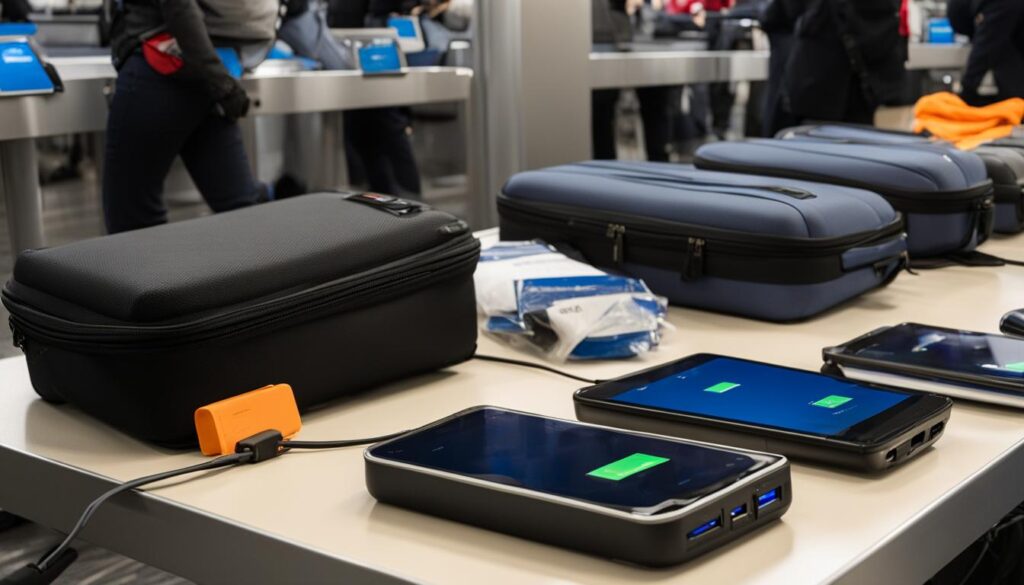
Remember, always check with your airline’s specific regulations regarding power banks and other electronic devices. These regulations may vary, so it’s crucial to stay informed to avoid any inconvenience or surprises during your journey.
Packing Tips for Electronic Devices
When traveling, it’s essential to pack your electronic devices properly to ensure their safety and functionality throughout your journey. Here are some packing tips for electronic devices, including how to pack chargers for travel and how to pack electronics in your luggage.
Carry-On Baggage
When it comes to electronic devices, it’s always best to pack them in your carry-on baggage rather than your checked luggage. This way, you have direct control over your devices and can prevent potential damage or loss. Additionally, having your devices in your carry-on allows you to keep them easily accessible during your flight.
Tip: Use a dedicated electronics organizer or pouch to keep your devices and chargers organized and prevent tangling.
Packing Chargers
When packing chargers for travel, it’s a good idea to keep them separate from your electronic devices. This helps prevent any potential damage that may occur if the devices shift during transit. Pack chargers in a designated section of your carry-on bag, preferably in a separate compartment or pouch.
Tip: If you have chargers with batteries, such as power banks, remove them from the devices and pack them separately. This helps comply with airline regulations and ensures your safety and the safety of other passengers.
Protective Cases
Consider investing in protective cases or sleeves for your electronic devices. These cases provide an extra layer of protection against scratches, bumps, and other travel-related hazards. Make sure the cases are the correct size for your devices to ensure a snug fit and optimal protection.
Tip: Label your electronic devices and chargers with your contact information. This can be helpful in case your devices get misplaced or left behind during your travels.
By following these packing tips for electronic devices, you can ensure that your devices arrive at your destination in perfect condition and that you have everything you need to stay connected and entertained throughout your journey.
Prohibited Items in Check-In Baggage
When packing your check-in baggage, it’s important to be aware of the items that are prohibited for safety and security reasons. Airlines have strict guidelines in place to ensure the well-being of all passengers onboard. By familiarizing yourself with these restrictions, you can avoid delays and potential issues during the check-in process.
Prohibited Items:
- Explosives: This includes fireworks, flares, and dynamite. These items pose a significant risk and are strictly prohibited in check-in baggage.
- Flammable Liquids and Gases: Items such as gasoline, lighter fluid, and butane gas canisters are highly flammable and should not be packed in your check-in baggage.
- Weapons and Firearms: Guns, knives, and other weapons are prohibited from being carried in check-in baggage. These items should be declared and properly packed in accordance with airline regulations.
- Toxic Substances: Items such as pesticides, bleach, and certain chemicals are considered hazardous and cannot be packed in check-in baggage.
- Valuables: Jewelry, cash, important documents, and other valuable items should always be kept in your carry-on baggage. It’s best to keep these items with you at all times to minimize the risk of loss or theft.
- Medications: Essential medications should be carried with you in your carry-on baggage, especially if they need to be taken during the flight. It’s important to have easy access to any necessary medications throughout your journey.
It’s crucial to review the specific guidelines of your airline before packing your check-in baggage. These rules may vary, so it’s essential to stay informed to avoid any unexpected issues or confiscation of prohibited items. By being mindful of these restrictions, you can ensure a smooth and hassle-free travel experience.
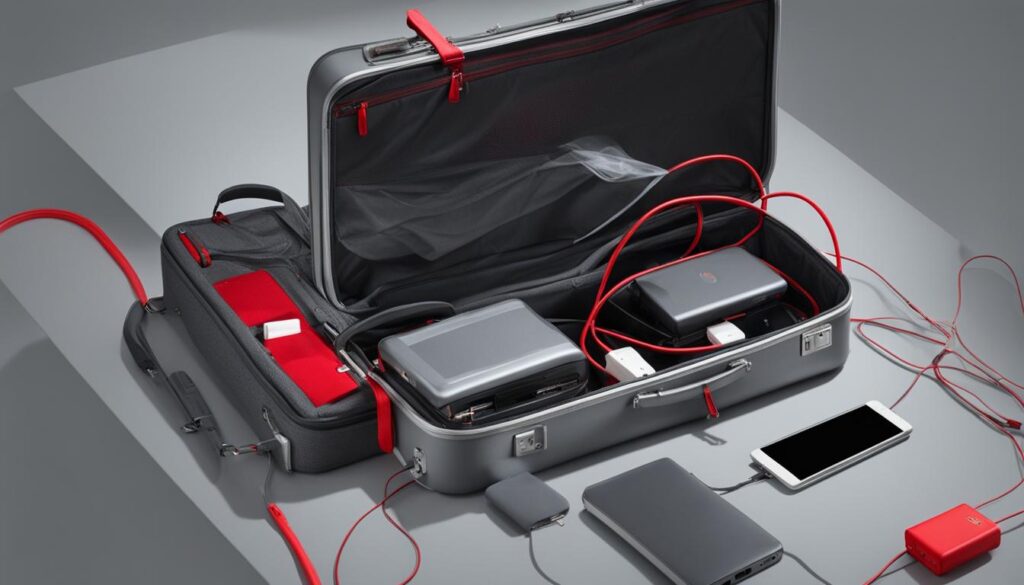
TSA Regulations on Lithium Batteries
When it comes to lithium batteries, the Transportation Security Administration (TSA) has specific regulations in place to ensure the safety of passengers and crew members. It’s important to understand these rules before you pack your bags, especially if you plan to bring devices with lithium batteries or spare batteries with you on your flight.
According to TSA guidelines, spare lithium-ion batteries and lithium metal batteries are not allowed in checked baggage. These types of batteries must be carried in your carry-on baggage instead. This is because lithium batteries have the potential to overheat and catch fire, posing a serious risk to the aircraft. By keeping them in your carry-on bag, you can easily access them if needed and reduce the risk of any accidents during the flight.
However, there is an exception for lithium-ion batteries that are installed in electronic devices, such as laptops. These batteries are allowed in checked baggage, as long as they are properly installed in the device. It’s worth noting that the airline you are flying with may have additional regulations or restrictions, so it’s always a good idea to check their specific guidelines before your trip.
| Lithium Battery Type | Allowed in Checked Baggage | Allowed in Carry-On Baggage |
|---|---|---|
| Lithium-ion batteries (installed in devices) | Yes | Yes |
| Spare lithium-ion batteries | No | Yes |
| Lithium metal batteries | No | Yes |
By following these regulations, you can help ensure a safe and smooth journey. It’s always important to stay informed and comply with the TSA’s guidelines to prevent any potential hazards associated with lithium batteries during air travel.
Tips for Airport Security Screening
When it comes to airport security screening, it’s important to be prepared and informed. Here are some helpful tips to ensure a smooth and efficient process:
- Arrive Early: Give yourself plenty of time before your flight to go through security. This will help alleviate any stress or rush, allowing you to calmly navigate the screening process.
- Organize Your Electronics: Before reaching the security checkpoint, make sure your electronics, including chargers, are easily accessible in your carry-on bag. This will save time and prevent any hold-ups during the screening process.
- Follow TSA Rules: Familiarize yourself with the Transportation Security Administration (TSA) rules and regulations regarding electronic devices. This will help you understand what is allowed and what may need additional screening or inspection.
- Remove Your Electronics: When you reach the security checkpoint, remove your electronics from your bag and place them in a separate bin. This includes laptops, tablets, phones, and chargers. This will allow the security agents to easily and thoroughly inspect your electronics.
- Stay Calm and Cooperative: The security screening process can be intimidating, but it’s important to remain calm and cooperative. Follow the instructions given by the security agents and be patient with any additional screening procedures that may be required.
By following these tips, you can ensure a hassle-free experience during airport security screening. Remember to stay informed, be prepared, and stay calm throughout the process. Safe travels!
Importance of Carry-On Baggage for Essential Items
When preparing for a flight, one of the most important considerations is what to pack in your carry-on baggage. While it may be tempting to rely solely on your checked luggage, keeping essential items with you in your carry-on can provide peace of mind and ensure a comfortable journey.
Having important items, such as medications, travel documents, and valuable belongings, easily accessible in your carry-on is crucial. In the event of delayed or lost checked baggage, having these essentials within reach can help you navigate any unforeseen circumstances. Additionally, keeping valuable and irreplaceable items with you ensures their safety and minimizes the risk of loss or theft.
Furthermore, packing essentials in your hand luggage allows you to maintain personal hygiene and comfort during your flight. Items such as toiletries, a change of clothes, and basic personal care products can make a significant difference in your overall travel experience. This is especially important for long-haul flights or situations where you may not have immediate access to your checked baggage.
Lastly, having important items in your carry-on bag allows you to be self-sufficient and prepared for any unexpected situations. Whether it’s a sudden change in weather, flight delays, or medical emergencies, having essential items readily available can help you navigate these challenges with ease. Being self-sufficient in these situations also minimizes the need to rely on others or purchase last-minute items at high prices.
Table: Essential Items to Pack in Carry-On Baggage
| Category | Items |
|---|---|
| Travel Documents | Passport, ID card, boarding passes, travel insurance information |
| Medications | Prescription medications, over-the-counter remedies |
| Valuables | Jewelry, cash, electronic devices |
| Toiletries | Toothbrush, toothpaste, deodorant, face wipes |
| Comfort Items | Travel pillow, blanket, eye mask, earplugs |
| Entertainment | Books, magazines, portable electronic devices |
| Snacks | Non-perishable snacks, empty water bottle |
By packing these essential items in your carry-on baggage, you can ensure a smoother and more comfortable travel experience. Remember to comply with airline regulations regarding liquids and size restrictions to avoid any issues during the security screening process. With your carry-on bag well-equipped, you can embark on your journey with confidence and peace of mind.
Conclusion
After exploring the regulations and guidelines for carrying chargers in check-in baggage, it is clear that it is generally allowed. However, it is highly recommended to keep chargers in your carry-on bag for added safety and convenience.
Chargers with built-in batteries should always be kept in your handheld luggage to minimize the risk of fire hazards. It’s always a good idea to check with your specific airline for any additional rules or restrictions they may have regarding chargers.
Remember, the advantages of keeping chargers in your hand luggage include easy accessibility, the ability to use your devices during the journey, and protection against mishandling or damage. Furthermore, packing essential items and valuables in your carry-on bag ensures their safety and availability throughout your flight.
To ensure a smooth airport security screening process, keep your chargers and other electronics easily accessible in your carry-on bag, and familiarize yourself with the TSA rules and regulations. By following these guidelines, you can enjoy a stress-free travel experience while keeping your chargers and other electronic devices secure.
FAQ
Are chargers allowed in check-in baggage?
According to TSA regulations, laptop chargers and phone chargers are allowed in check-in baggage. However, chargers with built-in batteries should be kept in your carry-on bag. Each airline may have its own specific rules, so it’s important to check their website or contact them directly for clarification.
Why should chargers with batteries be kept in carry-on baggage?
Chargers with batteries, such as those with lithium-ion batteries, pose a fire risk and are not allowed in check-in baggage. Lithium-ion batteries have the potential to malfunction and cause short circuits, which can lead to fires. Keeping chargers with batteries in your handheld luggage is safer.
Where is the best place to keep laptop chargers?
The best place to keep your laptop charger is in your handheld luggage or carry-on bag. This ensures that it stays with you and is easily accessible during your journey.
What are the advantages of keeping chargers in hand luggage?
Keeping chargers in your hand luggage allows you to ensure their security, use them during your journey, and prevent potential mishandling or damage that could occur in checked baggage.
Can power banks be kept in check-in baggage?
The TSA prohibits passengers from keeping power banks in check-in baggage, especially if they have lithium-ion batteries. Power banks should be kept in carry-on bags or carried on your person.
How should electronic devices be packed?
It is recommended to keep electronic devices, including chargers, in your carry-on bag to protect them from damage. Use a dedicated electronics organizer or pouch to keep them organized and prevent tangling. If you have chargers with batteries, make sure to remove them from the devices and pack them separately in a designated section of your carry-on bag.
What items are prohibited in check-in baggage?
Prohibited items in check-in baggage include electronics with lithium-ion batteries, flammable items, valuable items like jewelry and cash, and essential medications for your flight. Familiarize yourself with your airline’s specific guidelines before packing your check-in baggage.
What are the TSA regulations on lithium batteries?
The TSA prohibits spare lithium-ion batteries and lithium metal batteries in checked baggage. These batteries must be carried in your carry-on baggage. However, lithium-ion batteries installed in devices, such as laptops, are allowed in checked baggage.
What are some tips for airport security screening?
When going through airport security, keep your electronics, including chargers, easily accessible in your carry-on bag. Remove them from your bag and place them in a separate bin during the screening process. Familiarize yourself with the TSA’s rules and regulations to avoid any delays or issues at the security checkpoint.
Why is carry-on baggage important for essential items?
Packing essential items, such as medications and valuable belongings, in your carry-on baggage ensures that you have easy access to these items during your flight and minimizes the risk of loss or damage. In the event of delayed or lost checked baggage, having essential items in your carry-on bag can provide peace of mind.

